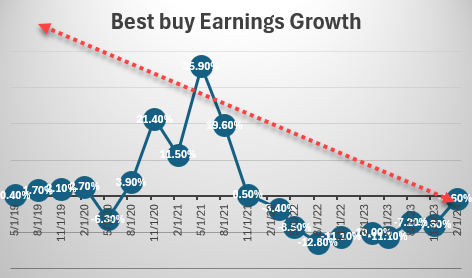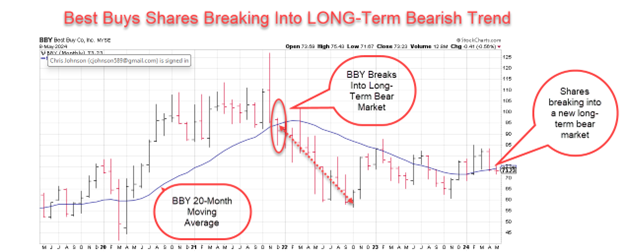There's no better way to start a Fast Profit segment than with a walk down Wall Street. And that's exactly what we’ll do this week.
I found myself returning home on Sunday to a refrigerator that had broken down.
This is an appliance in my house that has given me headaches for the last five years, so there was no thought, I just decided that I was replacing this thing right away.
I’ll spare you the details, but I found myself in a familiar place browsing new refrigerators. Regular readers aren’t going to be shocked that it was my local Costco (COST). But that wasn’t the first place I stopped.
There’s a Best Buy (BBY) store about half of the drive to my Costco so I figured I would check out their deals. Like I said, this damn refrigerator has been giving me headaches for years, its replacement was determined months ago.
I walked through the doors of the blue and yellow façade – already angering to the died in wool Ohio State alumni like me – only to be disappointed. After winding my way through the poorly laid-out store to find some of the largest products they have for sale, the selection and pricing were way off from that I’d already seen.
This isn’t the beginning of the end, but the end’s not far away is what I started thinking about Best Buy stock.
I followed my hunch on Monday and here’s the view of the stock from my Behavioral Valuation approach.
Fundamentals: Bearish
The post-pandemic stimulus check world extended Best Buy’s life. That’s what I thought as soon as I saw the trend in revenue.
Over the last year, Best Buy’s revenue has been on a notable downtrend, except for the period from August 2020 – May 2021. Those quarters are well known for benefiting retailers as consumers were out spending their stimulus checks and pandemic savings. Looking back over the last ten years this is the only anomaly in a trend that has otherwise continued lower.
It’s no wonder. From a competition perspective, Best Buys is in a retail street fight with Apple (AAPL), Target (TGT), and Walmart (WMT) when it comes to many of the electronics the company sells. The effects of that fight have left Best Buy to operate on thinner margins while revenue continues to be throttled by competition.
A “Walk Down Main Street” note: I asked all three of my children – aged 24-30 – what the top three places they would go to buy a TV. All three replied with Costco, Target, and Walmart, in that order. Two things to note, even the young consumers want to touch their large electronic purchases and they’re not even thinking about doing it at Best Buy.
One more casual note… It’s not a great commentary on the business from a consumer’s perspective when many of your locations were adjacent to Bed Bath & Beyond along with other retail dinosaurs. Just an observation.
Technicals: Bearish
I always say that price rarely lies, a rule that applies to Best Buy’s current technicals.
The intermediate-term charts for Best Buy are in the process of going from neutral to bearish.
The stock’s 50-day moving average is in the process of rolling over from a bullish trend higher into a bearish decline. A good rule of thumb to use when looking at any stock’s 50-day moving average is that a lower trend means that the stock is likely to close lower 2 out of three days during that trend.
As I type this, Best Buy shares are in the process of breaking below their longer-term 200-day moving average. This is the trendline that you will hear most Wall Street analysts talk about, meaning that a break below it will increase selling pressure.
As if we need more to be concerned about, we don’t, Best Buy’s stock is preparing to fall into a long-term bear market trend.
The stock’s 20-month moving average currently sits at $74. A stock is considered in a long-term bear market when it breaks below this trendline. The last similar move for Best By came in December 2021. The result of that long-term bear market trend was a seven-month selling spree that cut 40% from Best Buy’s value.
Bottom line on the technicals. Best Buy stock sits just above breaking into another long-term bear market trend.
Sentiment: Neutral
Sentiment towards Best Buy is firmly neutral.
Short sellers have started increasing their position on the stock, indicating that there’s blood in the water. The current short interest ratio of 5.1 is far from high enough for the stock to be considered a “short squeeze” candidate.
Options traders are another story. We look to the options market for signs of directional speculation and there’s no lack of it in Best Buy’s case.
The current open Interest put/call ratio sits at 1.18. Any ratio above 1.0 indicates that there are more puts open on a company than calls, suggesting that the options market is looking for a bearish move from Best Buy stock.
Looking more closely at where those calls are positioned, the options market is focusing on the stock breaking below $72.50 ahead of its earnings report on May 30. Further out, options traders are speculating on prices dipping towards $55 by September.
Finally, Wall Street’s view on the stock is… neutral.
Current analyst activity for Best Buy show analyst recommending the stock as a “hold” with only 34% buying the stock. 
The analyst’s current target price of $86 is lofty as the stock slips into bear market territory.
Analyst’s target prices on Best Buy fell from $120 to $90 during its last bear market. A poor earnings report on May 30 could trigger price and outlook downgrades from Wall Street, pressuring the stock into a volatile selloff.
Summary Outlook for Best Buy
Given all three perspectives of my Behavioral Valuation analysis, Best Buy shares’ risk far outweighs their reward making them an intermediate-term bearish opportunity.
Those investors holding the stock should consider tight stop-loss triggers to exit the position before losses mount.
Investors with an education and background and experience with options may consider intermediate-term puts as a method for profiting from Best Buy’s downside potential.
Moderate traders may consider the September 20, 2024 $75 puts as an attractive option. The options’ current price of $5.00 sets a break-even price for Best Buy shares of $70, a price that the stock will easily break on any bad news in the upcoming earnings report.
Using the Black-Scholes method of calculating option prices, a move to $65 in the next 30 trading days would result in a price of $11.25 for these options, a better than 100% gain.
Make certain to use trailing stops or other measures to lock-in profits once these options trade at more than 35% profits or more.
About the Author
Chris Johnson (“CJ”), a seasoned equity and options analyst with nearly 30 years of experience, is celebrated for his quantitative expertise in quantifying investors’ sentiment to navigate Wall Street with a deeply rooted technical and contrarian trading style.






